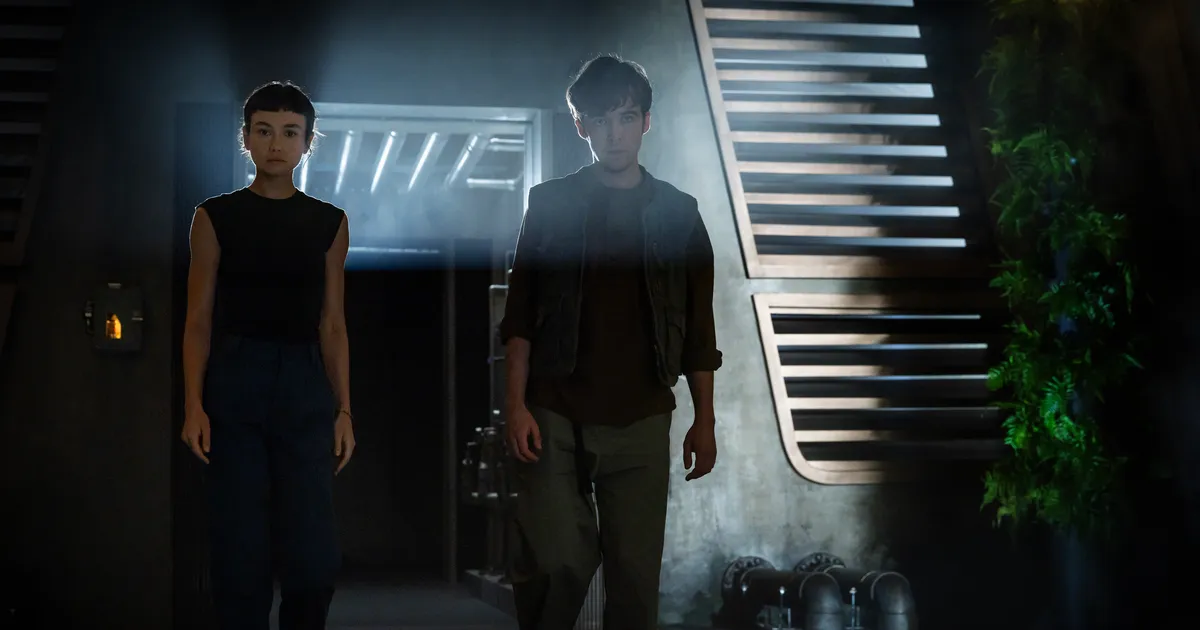
Given how long it takes these days for a big-budget, effects-heavy TV series to make it to the screen, we probably don’t talk enough about how many shows are still recovering from the various circumstances that ground show business to a halt in recent years. Alien: Earth’s production was first stalled by COVID and then by multiple Hollywood strikes, and while it’s impossible for the audience to know whether those delays affected the finished product, surely the impact wasn’t nonexistent.
You get why I’m mentioning this, right? It’s because the way this first Alien: Earth season ends is a little … odd. Nearly everything that worked well in the first half of season one has remained strong in the second half: the darkly comic machinations of the monsters, the thoughtful examination of what defines a “human,” and the gung-ho performances by actors who are playing some pretty far-out characters. (They’re kids! They’re robots! They’re robot-kids!) But while the first four episodes were well-plotted and sure-footed — building up to episode five’s ambitious Alien remix — the final three have been relatively attenuated. It’s as though Noah Hawley ran out of story before he ran out of episodes.
I don’t want to sound too negative, because on its own merits, the season finale, “The Real Monsters,” is plenty entertaining. It’s creepy and funny, and it ends in a promising place, setting up a potential season two. (That title though? Oof. Even Rod Serling would say it’s too obvious.) It’s just that this show is so good so often that its sloppier moments become more disappointing. Alien: Earth set such a high bar early on. The season-one finale approaches that bar, but never quite clears it.
In its broadest outline, the second half of season one has been about the arrogance of Boy Kavalier and his Prodigy minions leading not just to the Maginot’s planet-endangering alien specimens getting loose, but also to Kavalier’s “Lost Boys” recognizing that they have more power than their creators. By the end of the finale, Neverland Island has become the home base for a cadre of nonhumans who could very well take over the world.
So while last week’s episode focused more on the aliens, “The Real Monsters” is about the humanoids, both synthetic and organic. The organic initially has the upper hand. After the attempted escape at the end of the previous episode — the one that Joe Hermit helped thwart to Wendy’s dismay — the hybrids have been herded into a containment cell, while Kavalier considers his next steps.
And it’s a pressing concern for a few reasons. While the Prodigy troops have neutralized the Weyland-Yutani invasion for now, reinforcements are surely on the way. Also, Wendy’s pet Xenomorph is still running wild, ripping through any humans it finds. Perhaps most important, the Lost Boys could easily get out if they tried.
They will, of course, eventually do just that. First, they must set aside their personal grudges and undergo some consciousness-raising. This is a much more dialogue-heavy episode than what we saw last week, but there’s a lot of drama in those conversations, especially when Wendy tries to get Curly to understand that she was never Kavalier’s “favorite.” (“In the book Wendy Darling is Peter Pan’s favorite,” Wendy says. “And then she grew up, and that made Peter mad.”) Bit by bit, the hybrids assert their own personalities and even start reclaiming their original names, first by insisting that Tootles not be called either Tootles or Isaac, but Steven … or Steve-O, what his mom called him.
The scales fully fall from Curly’s eyes after she confronts her creator face-to-face. In what is Samuel Blenkin’s best scene of the season as Boy Kavalier, the wunderkind recounts his origin story to the Lost Boys. Apparently, he built his first synth at age 6 to kill and then serve as a replacement for his no-good alcoholic father. Yet whatever affection he may feel for his mechanical companions, he can’t get past the streak of paternalistic cruelty he inherited from his old man. He tells Curly and company that they’re just a means to an end, quipping, “Sweeties, you’re floor models,” before angrily hissing, “But you’re fucking it up, you’re fucking it up!”
As the hybrids escape, Curly tells Wendy, “My name’s Jane.” It’s at this moment that I wish we’d gotten more of Curly/Jane prior to the finale. Even though there’s not much plot in the season’s last three episodes, it still feels sometimes like a few scenes went missing. I mentioned a couple of weeks back that it was strange for Wendy to be so well-informed about Nibs’s mental breakdown, given that we never got a moment onscreen when Wendy was told about what had happened. There’s been a lot of the show skipping ahead lately — including the big jump at the start of this week’s episode, eliding the moment when Wendy was captured and brought back to the main facility.
A lot of Morrow’s story line has been similarly shortchanged, though ultimately the character has served a purpose by sitting on a different side of the human-machine amalgam scale. In this story about the triumph of evolution, it’s fitting that Morrow gets bested by Kirsh, who first gets heavily damaged by the cyborg before reminding his nemesis about how the story of John Henry and his ten-pound hammer actually ended. Yes, the human beat the machine. Then the man died of exhaustion.
There is one other machine-man the hybrids have to deal with by episode’s end: Atom, Kavalier’s burly enforcer. (Did we already know Atom was a synth? Sometimes I’m not sure whether Hawley held some story points back because he wanted them to be a surprise or if he just forgot to mention them earlier.) While Atom is trying to manipulate Hermit into becoming the eyeball monster’s new human host, Joe first hides in a cage — in one of the episode’s most enjoyably scary scenes — before Wendy comes to her brother’s rescue, using her machine-controlling superpowers to stop Atom cold.
This prompts another philosophical debate between the Hermit siblings. Joe tries to apologize for neutralizing Nibs in the previous episode, and tries to caution Wendy/Marcy yet again about cozying up too much to these killer aliens. “We’re food to them,” he says. “You’re food to them,” she answers. She also announces a revelation she’s just had: Ultimately, she’s neither Marcy nor Wendy, but something else.
There’s been a bluntness all season to the Hermits’ chats that ordinarily might grate on me. But I’ve largely enjoyed these scenes, thanks to the quiet earnestness of Sydney Chandler’s and Alex Lawther’s performances. These two are rarely histrionic. They play these characters’ concerns as genuine and well-meaning, and they do so effectively. Wendy can say things like, “That is what powerless people say to make doing nothing okay” when Joe calls life “complicated,” or, “You’ve always been a man … a mean, angry little man who decided to hate everybody, just like your daddy” to Kavalier without ever tipping too far into the cringe-inducing.
The overall awesomeness of Wendy (or whatever she eventually decides to call herself) sends this finale and season out on a high note, despite the episode’s more middling qualities. Everything Wendy does this week just looks cool, thanks in part to her impressive calm and sense of purpose, and thanks even more to the way she’s framed: often from a low angle, at the center of the composition, surrounded by her minions. (And when she clicks to summon the Xenomorph, who we then see in one of those nifty Alien: Earth superimpositions? Sublime.)
When Nibs mutters “We’re all ghosts” at the start of the episode, Wendy realizes that ghosts are scary, and she embarks on a righteous mission of usurpation, haunting the humans and the other synths. Eventually, she and her allies round up all their enemies, sticking Atom, Morrow, Kirsh, Dame, and Kavalier behind bars. Then Wendy, with the adult and the baby Xenomorph in her thrall, says, “Now we rule.”
I’m a big fan of George Romero’s zombie movies, and one key characteristic that the Alien franchise shares with those films is the idea that whatever safeguards humanity put in place to protect us from the monsters will eventually fail, due to the laws of entropy and the flaws of human nature. These stories aren’t cautionary tales so much as they’re brutally frank reports about How Things Are.
But what distinguishes Alien: Earth — and why, whatever reservations I have about this finale, I’m excited for a second season — is that it doesn’t necessarily see this recurring cycle of destruction as a tragedy. After all, we’ve had our turn. Let’s give the monsters a chance.
Screaming, Hearing, Etc.
• In a previous review I noted that I found Smee’s “giving you a grown-up hug” gesture to be kind of cheesy, but I have to admit: When Smee wraps his arms around Wendy to show his support for her, it’s genuinely moving.
• It may seem cruel to consign Dame Sylvia to Bad Grown-up prison, but as Wendy notes, no matter her intentions, Dame did “put six children in the ground.” Joe Hermit is the only adult human who gets to roam freely right now, but even he’s on a short leash. At the end of the episode he’s most often seen in shots by himself, spatially isolated from the hybrids.
• What, did you think I was going to make it through this entire recap and not mention the fate of the eyeball monster, 2025’s best new TV character? The wee beastie ends the season in Arthur’s body, ready to continue its freaky little business.
• I want to end by noting another fun moment involving Arthur Sylvia’s corpse: when a crab crawls onto Arthur’s open chest wound and then scares off an approaching Xenomorph with its tiny claws. And who can blame the alien? Crabs may be small, but those pincers can do a lot of damage. Never underestimate shellfish.



